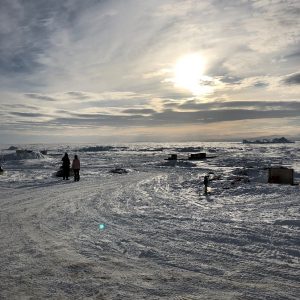Water Research in Canada’s Arctic
For the past year I’ve had the privilege of managing a water research project in one of the most northern communities in Canada, Pond Inlet (Mittimatalik), Nunavut. This community is located above the Arctic Circle and is one of the few inhabited places in the world where you can experience the midnight sun – that is, where the sun remains above the horizon 24 hours a day during the summer months. In the winter, conversely, the sun doesn’t rise for approximately three months. Average winter temperatures in Pond Inlet hover around -30oC, the ocean freezes, and the land is covered with snow. In the summer, however, much of the ice and snow melts to reveal a very different landscape of tundra, lakes, and ice floes.
The majority of the inhabitants of Pond Inlet identify as Inuit. The term “Inuit” refers to the Indigenous people living in the Arctic region of Canada. Inuit people are culturally and legally distinct from other Indigenous peoples in Canada. In general, the shared history of Canada’s Indigenous and settler populations has been tumultuous, and this is also true in the Arctic. Water services have been a particular area of concern. Canada’s current government has committed to improving drinking water services and ending boil water advisories in Indigenous communities, including those in the Arctic. The remote and challenging landscape and the lingering effects of colonialism in the North complicate this endeavour but efforts are currently being made at many levels of government to ensure that all people in the North have access to clean and safe drinking water.
Most communities in Canada’s Arctic rely on trucked water and septic because the climate prevents the installation of underground infrastructure such as distribution and collection piping systems. In many communities, drinking water treatment is limited to chlorination. The chlorinated water is delivered to individual homes and businesses by a water delivery truck and stored in domestic water storage tanks until it is used by residents. In some cases, the amount of water available in the tanks is not sufficient to meet the needs of residents (Daley et al., 2014).
Work by local researchers has identified biological growth in water storage tanks as a major concern among elders and other community members. Previous academic studies have also identified issues such as elevated turbidity, iron, manganese, and most concerningly, lead in the community’s drinking water (Daley et al., 2017). Our current project is a collaboration between a local research team in Pond Inlet, ARCTIConnexion and the Centre for Water Resource Studies at Dalhousie. Our team collectively seeks to understand the extent of these water quality issues and help the community develop a water safety plan to address them.
Our collective team is still processing the results of this year’s sampling program, which focused on tracking biological activity in tanks, household water quality, and temporal variations in water quality in the source water. Preliminary results were presented to the community and the hamlet council in July of this year and research is ongoing.
I strongly recommend that IWA YWP delegates seek out works by Indigenous writers and artists who have described their histories and experiences or who have documented Indigenous / settler relations in writing, visual art, or music ahead of their visit to Toronto for the 2019 IWA YWP Conference. The Art Gallery of Ontario, which is within walking distance of the conference venue, has an extensive collection of Indigenous art, including works by modern Inuit artists, that may be of interest to IWA YWP delegates.
Working in the community of Pond Inlet has been an interesting and humbling experience for me. I would like to acknowledge Tim Soucie, ArctiConnexion, and the community of Pond Inlet for their support and efforts over the course of this project.
Stephanie Gora is organizing committee member of the International Young Water Professionals Conference 2019 . IWA is now calling for abstracts and workshops submissions until 15 October. Read more…
Cited works:
Daley, K., Castleden, H., Jamieson, R., Furgal, C., Ell, L., 2014. Municipal water quantities and health in Nunavut households: An exploratory case study in coral Harbour, Nunavut, Canada. Int. J. Circumpolar Health 73. https://doi.org/10.3402/ijch.v73.23843
Daley, K., Truelstrup Hansen, L., Jamieson, R.C., Hayward, J.L., Piorkowski, G.S., Krkosek, W., Gagnon, G.A., Castleden, H., MacNeil, K., Poltarowicz, J., Corriveau, E., Jackson, A., Lywood, J., Huang, Y., 2017. Chemical and microbial characteristics of municipal drinking water supply systems in the Canadian Arctic. Environ. Sci. Pollut. Res. 1–12. https://doi.org/10.1007/s11356-017-9423-5
Reading lists:
University of Manitoba Centre for Human Rights Research: http://law.robsonhall.com/chrr/other-resources/critical-conversations/right-to-water-seminars/right-to-water-reading-list/
49th Shelf: https://49thshelf.com/Lists/Members/2015-05/Books-by-Indigenous-Women
Muskrat Magazine: http://muskratmagazine.com/fifteen-books-by-indigenous-authors-you-should-read
Government of Canada: #indigenousreads [https://www.aadnc-aandc.gc.ca/eng/1496255894592/1496255988109]



